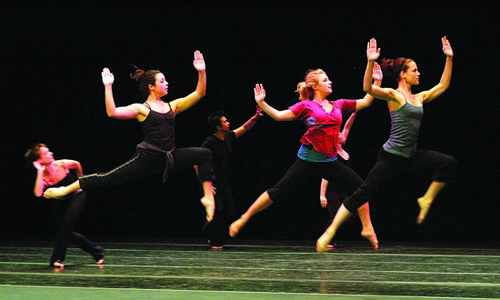
Rehearsing and performing with the José Limón Dance Company was a once-in-a-lifetime experience for Vanderbilt Dance Program students. Photo by Steve Green
For a university that doesn’t offer a dance major or minor, Vanderbilt attracts its fair share of dancers. In fact, more than 800 dancers from the Vanderbilt and Nashville communities take part in Vanderbilt Dance Program classes in ballet, jazz, modern, hip-hop and more. The thriving program, founded in the mid-1970s, serves as the main outlet for students wanting to train in dance while at the university.
“We have students who are very serious about pursuing a professional dance career, and we have students who simply want to satisfy their interest in dance while pursuing a Vanderbilt degree,” says JoEl Logiudice, director of the Office of Arts and Creative Engagement. “The dance program is a way to bridge those two worlds–their passions with their careers.”
When the renowned Limón Dance Company was added to last fall’s Great Performances lineup at Vanderbilt, it provided an unprecedented opportunity for a full-fledged dance residency, allowing selected students to audition, train and perform alongside company members for a performance of Limón’s Missa Brevis.
The José Limón Dance Company was founded in 1946 by Limón, a Mexican immigrant who specialized in a style of modern dance that was related to ballet, but used strong movements to express emotion and tell stories in abstract and unique ways. The New York Times called Limón “the finest male dancer of his time.”
Limón created Missa Brevis (it means “short mass”) after a 1957 trip to Poland, where he witnessed the Polish people’s ongoing efforts to rebuild after the devastation of World War II. A National Endowment for the Arts grant supporting the reconstruction of American dance masterworks at the nation’s universities enabled Vanderbilt to bring Limón’s Missa Brevis to campus.
Limón Dance Company’s artistic director, Carla Maxwell, traveled to Nashville to conduct auditions, which included a two-day workshop to orient students in the Limón technique. Auditions yielded five students to dance the roles of Missa Brevis’ “corps,” or chorus, and two understudies. For more than two weeks, the students trained under Clay Taliaferro, a former Limón principal dancer, with four to five hours of rehearsal several times during the week plus eight more on weekends.
Arts and Science senior Julia Byrd, a biology and pre-med major who has been dancing since age 10, says the long rehearsals felt like lengthy private lessons. “It was great to be at that level of professionalism.”
“The most valuable thing I learned is to ‘make the movement make sense.’ Clay repeated this phrase over and over in rehearsals,” says Schwannah McCarthy, a third-year law student chosen for the residency. “I have a tendency to get very cerebral when performing a dance, but the reality is, when you initiate movement in one part of the body, then another part of the body moves naturally in response. I learned to let go and trust that my body is ‘on the job.'”
Limón Dance Company members spent a week rehearsing with students, culminating in public performances by the full ensemble on Oct. 31 and Nov. 1.
“The great thing was that students were not an opening act or a separate piece,” says Bridgette Kohnhorst, assistant director of art and cultural programs and curator of the Great Performances Series. “They were enveloped into the ensemble of professional dancers, dancing side by side in the true spirit of a residency.”